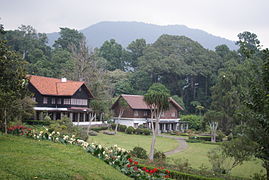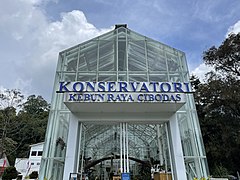
Caspar Georg Carl Reinwardt was a Prussian-born Dutch botanist. He is considered to be the founding father of Bogor Botanical Garden in Indonesia.

The Bogor Botanical Gardens is a botanical garden located in Bogor, Indonesia, 60 km south of central Jakarta. It is currently operated by the National Research and Innovation Agency. The garden is located in the city center and adjoin the presidential palace compound of Istana Bogor. It covers an area of 87 hectares and contains 13,983 different kinds of trees and plants of various origin. The geographic position of Bogor means it rains almost daily, even in the dry season. This makes the garden an advantageous location for the cultivation of tropical plants.
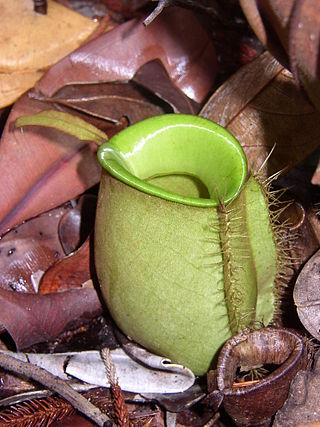
Nepenthes ampullaria is a very distinctive and widespread species of tropical pitcher plant, present in Borneo, the Maluku Islands, New Guinea, Peninsular Malaysia, Singapore, Sumatra, and Thailand.

Nepenthes reinwardtiana is a tropical pitcher plant native to Borneo and Sumatra and to a number of smaller surrounding islands including Bangka, Natuna, Nias, and Siberut. Although some sources have included Peninsular Malaysia and Singapore within the range of this species, these records appear to be erroneous.

Nepenthes glabrata is a tropical pitcher plant endemic to Sulawesi. The species grows in open, high forest at elevations of 1600 to 2100 m. It produces dainty, colourful pitchers reaching only a few centimetres in height. These traps are red speckled on a yellowish background, giving them a "hand painted" appearance.
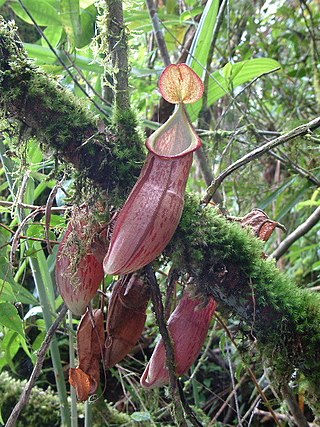
Nepenthes gymnamphora is a tropical pitcher plant native to the Indonesian islands of Java and Sumatra. It has a wide altitudinal range of 600–2,800 metres (2,000–9,200 ft) above sea level. There is much debate surrounding the taxonomic status of this species and the taxa N. pectinata and N. xiphioides.
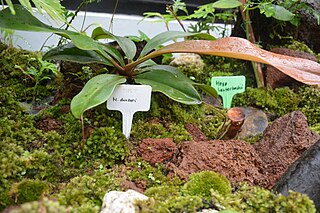
Nepenthes danseri is a species of tropical pitcher plant. It is known only from the northern coast of Waigeo Island; plants from Halmahera, the largest of the Maluku Islands, are now recognised as belonging to a separate species, N. halmahera.

Nepenthes × hookeriana, or Hooker's pitcher-plant, is a common natural hybrid involving N. ampullaria and N. rafflesiana. It was originally described as a species.

Puncak or Puncak Pass is a mountain pass in West Java, Indonesia. The pass connects the cities of Bogor and Bandung and is spread within the regencies of Bogor, Cianjur, and Sukabumi. Puncak Pass is located between Mt. Gede-Pangrango in the south and the Jonggol Mountains in the north. The highest point of the pass is about 1500 m altitude.
Cipayung is a district (kecamatan) of East Jakarta, Indonesia, situated in the southeastern part of Jakarta, in the outskirts of Jakarta. Its northern boundary is Pondok Gede Raya Road, its eastern boundary is Sunter River to the East, and its western boundary is Jagorawi Tollway. Marshes can still be found in Cipayung.

The Indonesian Institute of Sciences was the governmental authority for science and research in Indonesia. It consisted of 47 research centers in the fields ranging from social to natural sciences.
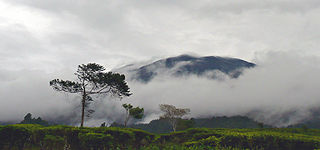
Mount Gede Pangrango National Park is a national park in West Java, Indonesia. The park is centred on two volcanoes—Mount Gede and Mount Pangrango—and is 150 km² in area.

Johannes Elias Teijsmann was a biologist, botanist and plant collector. He was born in Arnhem, The Netherlands. His surname is sometimes spelled Teysmann, although he spelled it Teijsmann.

The Bali Botanic Garden is the largest botanic garden in Indonesia and is located in the mountainous region of Bedugul, Tabanan Regency, central Bali, around 90 minutes drive north of Denpasar. The Garden was established on 15 July 1959 and is situated around 1300 metres above sea level overlooking Bratan Lake and the Ulun Danu Temple on the slopes of Tapak Hill. The Garden is a centre for botanical research, conservation, education and recreation. It is operated by the Indonesian Institute of Sciences (LIPI).

Cymbidium hartinahianum is an orchid endemic to North Sumatra, Indonesia. It was first found in 1976 by Rusdy E. Nasution, a researcher from Herbarium LBN/LIPI Bogor, at Desa Baniara Tele, Kecamatan Harian, Kabupaten Samosir, North Sumatra. This orchid is classified as 'extinct in the wild' and cannot be sold freely except as a human-propagated specimen. The flower can be found at Kebun Raya Bogor.

The Sukorambi Botanical Garden is a botanical garden located in Sukorambi, Jember Regency, East Java, Indonesia.

Taman Hutan Raya Ir. H. Juanda, locally shortened to "Tahura" is a conservation area and botanical garden in Bandung, Indonesia.
Purwodadi Botanical Garden is a research centre in Purwodadi, Pasuruan, East Java, Indonesia. It has an area of 85 hectares and more than 10,000 types of trees and many plant collections. Callus cultures of Agave amaniensis by Setia Dewi were taken in 1988.
Kuningan Botanical Garden is a botanical garden located at Padabeunghar village in Kuningan Regency, West Java, Indonesia. The botanical garden has a land area of 156 hectares, which is the largest in Indonesia. Kuningan Botanical Garden also served as nature-based ecotourism. The garden located near Mount Ciremai National Park opened in 2015, but closed down in 2016 due to unfinished construction projects.







